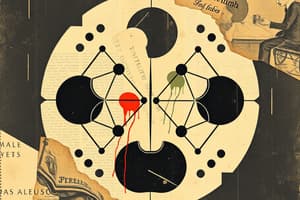Podcast
Questions and Answers
What is the sequence of phases in the cell cycle?
What is the sequence of phases in the cell cycle?
- S, G1, G2, M
- G2, M, G1, S
- M, G2, S, G1
- G1, S, G2, M (correct)
Which phase of the cell cycle is primarily involved in DNA replication?
Which phase of the cell cycle is primarily involved in DNA replication?
- S Phase (correct)
- G2 Phase
- M Phase
- G1 Phase
What is the main function of the G1 phase in the cell cycle?
What is the main function of the G1 phase in the cell cycle?
- Cell growth and preparation for DNA synthesis (correct)
- Cell division
- DNA replication
- Chromosome separation
Which of the following is NOT a stage of mitosis?
Which of the following is NOT a stage of mitosis?
What is one characteristic of asexual reproduction in cellular division?
What is one characteristic of asexual reproduction in cellular division?
What is the main difference between mitosis and meiosis?
What is the main difference between mitosis and meiosis?
During which stage of the cell cycle is the chromosomal material duplicated?
During which stage of the cell cycle is the chromosomal material duplicated?
What occurs during the G2 phase of the cell cycle?
What occurs during the G2 phase of the cell cycle?
What triggers the start of the cell division process?
What triggers the start of the cell division process?
Which phase of the cell cycle is primarily responsible for DNA replication?
Which phase of the cell cycle is primarily responsible for DNA replication?
Which statement about mitosis is correct?
Which statement about mitosis is correct?
What primarily occurs during the G2 phase of interphase?
What primarily occurs during the G2 phase of interphase?
Which phase of mitosis involves the alignment of chromosomes along the cell's equator?
Which phase of mitosis involves the alignment of chromosomes along the cell's equator?
What does cytokinesis primarily involve?
What does cytokinesis primarily involve?
Why might nerve and brain cells not undergo mitosis?
Why might nerve and brain cells not undergo mitosis?
What is the correct order of phases in mitosis?
What is the correct order of phases in mitosis?
What is a primary role of apoptosis during embryogenesis?
What is a primary role of apoptosis during embryogenesis?
What is the primary purpose of cytokinesis?
What is the primary purpose of cytokinesis?
Which statement describes a consequence of excessive apoptosis?
Which statement describes a consequence of excessive apoptosis?
In what situation is apoptosis particularly essential in adult tissues?
In what situation is apoptosis particularly essential in adult tissues?
Which structure forms as a result of cytokinesis in animal cells?
Which structure forms as a result of cytokinesis in animal cells?
What effect does reduced apoptosis have on cell populations?
What effect does reduced apoptosis have on cell populations?
Which of the following is true about telophase?
Which of the following is true about telophase?
What is apoptosis's role during the transition from a tadpole to a frog?
What is apoptosis's role during the transition from a tadpole to a frog?
What do cyclins and cyclin-dependent kinases (CDKs) primarily regulate?
What do cyclins and cyclin-dependent kinases (CDKs) primarily regulate?
What is the role of checkpoints in the cell cycle?
What is the role of checkpoints in the cell cycle?
During which phase of mitosis do sister chromatids align at the cell equator?
During which phase of mitosis do sister chromatids align at the cell equator?
What structure forms from the centrioles during telophase?
What structure forms from the centrioles during telophase?
What happens to the nucleolus during telophase?
What happens to the nucleolus during telophase?
What is the main role of the G1 checkpoint in the cell cycle?
What is the main role of the G1 checkpoint in the cell cycle?
What consequence arises from a defective p53 gene in a cell?
What consequence arises from a defective p53 gene in a cell?
Which statement best describes the difference between normal cells and cancer cells?
Which statement best describes the difference between normal cells and cancer cells?
What happens at the G2 checkpoint?
What happens at the G2 checkpoint?
What defines cancer in relation to cell division?
What defines cancer in relation to cell division?
Which type of cell death is described as energy-dependent and programmed?
Which type of cell death is described as energy-dependent and programmed?
How do cancer cells typically differ in their communication with neighboring cells compared to normal cells?
How do cancer cells typically differ in their communication with neighboring cells compared to normal cells?
What crucial role does the p53 protein play in the cell cycle?
What crucial role does the p53 protein play in the cell cycle?
Flashcards are hidden until you start studying
Study Notes
Introduction
- New cells are needed for growth, replacement of damaged cells, and increasing the number of cells.
- Cells are formed using asexual reproduction where mitosis (eukaryotes) and binary fission (bacteria) are used to produce identical cells.
- Sexual reproduction combines two cells to create a new cell that is not identical to the parent cells.
Cell Division
- Prokaryotes: Have a single circular DNA molecule that replicates and attaches to the cell membrane.
- Eukaryotes: Division is triggered when a cell reaches an appropriate size and has enough protein and energy stores, to prevent the cell from becoming too large, making nutrient and waste exchange difficult.
Cell Cycle
- The cell cycle is a series of stages that occur from when a cell divides into two cells until those daughter cells divide as well.
- Includes:
- Interphase:
- G1 Phase: Cell grows in size, and increases its supply of proteins and organelles for division.
- S Phase: DNA replicates, resulting in two sister chromatids per chromosome.
- G2 Phase: Second growth phase, all structures needed for division are created, including centrioles, and protein, and organelle synthesis.
- M Phase: Mitosis, or karyokinesis, where the nucleus divides. Occurs in eukaryotes only, some cells such as nerve and brain cells, do not undergo mitosis.
- C Phase: Cytokinesis, the physical process of cell division where the cytoplasm divides into two daughter cells with the help of actin and myosin contractile rings that form a cleavage furrow.
- Interphase:
- Mitosis:
- Consists of four stages (PMAT):
- Prophase: Chromatin condensates into chromosomes, the nucleolus and nuclear membrane disappear, and the mitotic spindle formation begins from centrioles.
- Metaphase: Chromosomes attach to kinetochore fibers and line up along the cell equator.
- Anaphase: Spindle fibers pull sister chromatids apart to opposite poles, each pole with a full set of original genes.
- Telophase: Chromosomes reappear as chromatin, the nuclear envelope begins to form, the nucleolus is visible, and the spindle breaks apart.
- Consists of four stages (PMAT):
- Cell division assists in growth, repair, and replacement of damaged cells within tissues.
Regulation of Cell Cycle
- Aims to control cell division to prevent uncontrolled cell division and tumor formation.
- Regulatory molecules: cyclins and cyclin-dependent kinases (CDK)
- These molecules form a heterodimer that activates or deactivates target proteins through phosphorylation.
- Checkpoints ensure proper cell cycle progression:
- G1 Checkpoint: Verifies that everything is ready for DNA replication.
- G2 Checkpoint: Checks that the cell is ready for mitosis.
- Metaphase Checkpoint: Ensures that the cell is ready to complete cell division.
- Loss of Cell Cycle Control leads to tumor formation.
- A damaged or defective p53 gene causes a loss of information needed to respond to control signals. Cancer cells with faulty p53 lack responsiveness to cell cycle control signals, leading to uncontrolled cell division.
- Normal Cells: DNA replicates correctly, chemical signals start and stop the cell cycle, cells communicate to prevent overcrowding.
- Cancer Cells: DNA replicates with mutations, chemical signals for starting and stopping the cell cycle are ignored, cells don't communicate, leading to the formation of tumors.
- Cancer: Essentially a failure of cell division control.
- All cancers require a shutdown of p53 activity, which plays a key role in the G1/S checkpoint and halts cell division if damaged DNA is detected.
Cell Death
- Necrosis: Unregulated cell death caused by disease, injury, or lack of blood supply.
- Apoptosis: Regulated cell death for the removal of unwanted cells. This is an energy-dependent process.
- Necrosis VS Apoptosis:
- Necrosis is a massive, uncontrolled event, while apoptosis is a controlled, individual cell process.
- Necrosis causes cell swelling, while apoptosis leads to cell shrinking.
- Necrosis results in inflammation, whereas apoptosis prevents inflammation.
- Apoptosis in Physiological Situations:
- About 100,000 cells are produced each second by mitosis, with a similar number dying by apoptosis.
- Embryogenesis: Apoptosis plays a role in morphogenesis to eliminate excess cells, for example, between fingers and toes.
- Metamorphosis: Apoptosis assists in the transformation of a tadpole into a frog.
- Apoptosis in Adults:
- Tissue Remodeling: Apoptosis eliminates unwanted cells through tissue renewal. Example: the mammary glands.
- Prostate Gland: Testosterone controls the level of apoptosis in the prostate gland.
- Apoptosis in Disease:
- Too Much Apoptosis: Tissue atrophy, neurodegeneration.
- Too Little Apoptosis: Hyperplasia, athersclerosis.
Studying That Suits You
Use AI to generate personalized quizzes and flashcards to suit your learning preferences.




